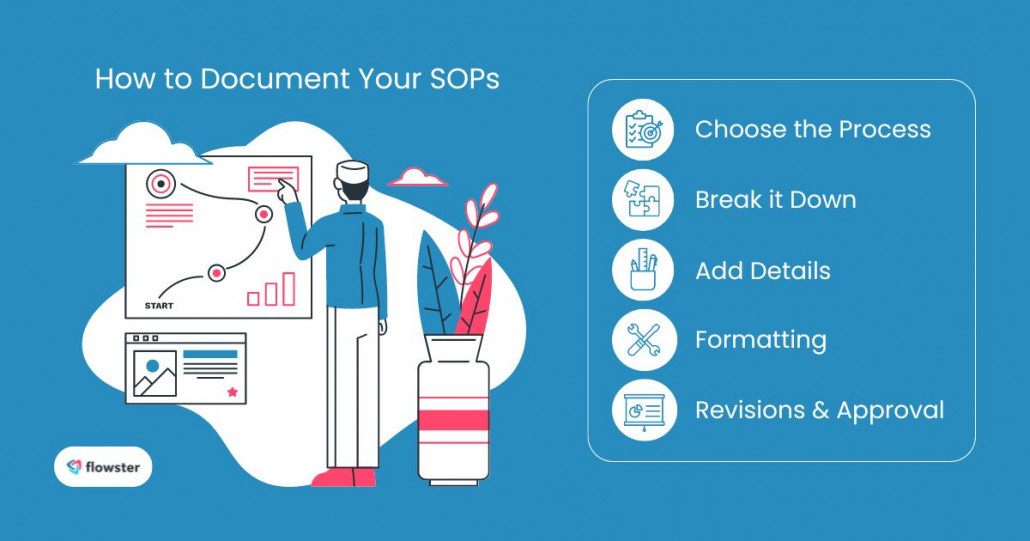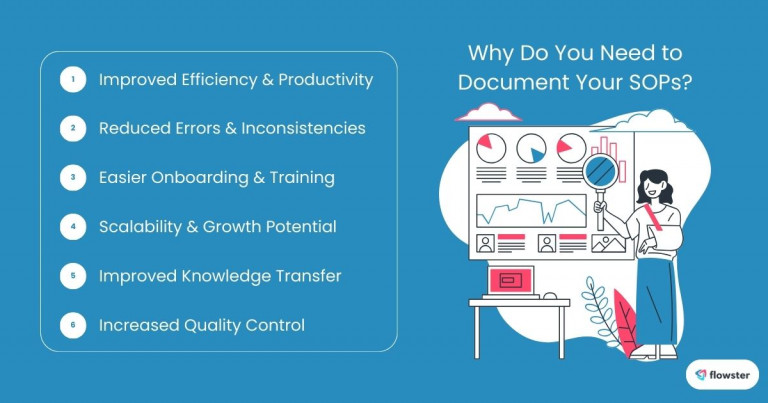As small and medium businesses (SMBs) scale, they often encounter challenges like inconsistent processes, knowledge loss, and difficulty onboarding new employees. These growing pains can hinder efficiency, productivity, and overall growth. One effective solution to address these issues is to document Standard Operating Procedures (SOPs).
SOPs are detailed step-by-step instructions that outline how specific tasks or processes should be carried out within an organization. By documenting SOPs, businesses can create a standardized framework that ensures consistency, efficiency, and accountability.
This guide aims to provide a clear and actionable roadmap for SMBs to document their SOPs effectively. We’ll delve into the benefits of documenting SOPs, key considerations, and a step-by-step process to help you streamline your operations and drive growth.
Article Outline
Understanding SOPs: A Foundation for Business Success
An SOP, or Standard Operating Procedure, is essentially a detailed roadmap that outlines the steps involved in completing a specific task or process within an organization. It serves as a comprehensive guide for employees, ensuring that tasks are performed consistently, efficiently, and with minimal errors. By following SOPs, businesses can standardize their operations, reduce training time, and improve overall productivity.
How SOPs Ensure Consistency and Efficiency
- Standardization: SOPs create a uniform approach to tasks, eliminating inconsistencies and variations that can lead to quality issues or delays.
- Efficiency: By providing clear guidelines, SOPs help employees complete tasks more quickly and accurately, reducing the time and resources required.
- Consistency: SOPs ensure that tasks are performed in the same way every time, leading to more predictable outcomes and improved customer satisfaction.
A Real-World Example: Onboarding New Customers
Consider a small business that sells products online. An SOP for onboarding new customers might include the following steps:
- Customer Verification: Verify the customer’s identity and shipping address.
- Order Processing: Create a new order in the company’s system.
- Inventory Management: Update inventory levels to reflect the new order.
- Payment Processing: Process the customer’s payment using the preferred method.
- Shipping Preparation: Prepare the order for shipment and generate a shipping label by considering print and apply label systems.
- Shipment Tracking: Track the shipment and notify the customer of the order status.
By following this SOP, the business can ensure that all new customer orders are processed consistently and efficiently, reducing the risk of errors and improving customer satisfaction.
The Power of Documented SOPs: Unlocking Business Growth
Documenting SOPs offers numerous benefits for small and medium businesses. By creating a clear and accessible reference for employees, businesses can streamline operations, reduce errors, and foster a culture of efficiency.
Improved Efficiency and Productivity
- Clear Guidelines: Documented SOPs provide employees with clear instructions on how to perform tasks, eliminating confusion and reducing the time it takes to complete them.
- Reduced Errors: By standardizing processes, SOPs help to minimize errors and inconsistencies, leading to higher quality output and reduced waste.
Reduced Errors and Inconsistencies
- Consistency: Documented SOPs ensure that tasks are performed in the same way every time, reducing the risk of variations that can lead to quality issues or customer dissatisfaction.
- Accountability: SOPs can help identify and address areas where errors occur, improving accountability and driving continuous improvement.
Easier Onboarding and Training of New Employees
- Accelerated Learning: New employees can quickly become productive by referring to documented SOPs, reducing the time and resources required for training.
- Knowledge Transfer: SOPs serve as a valuable repository of knowledge, ensuring that critical information is easily accessible to new and existing employees.
Scalability and Growth Potential
- Predictability: Documented SOPs provide a foundation for predictable and scalable operations, allowing businesses to grow and expand without sacrificing quality.
- Consistency: As a business grows, SOPs can help maintain consistency across teams and departments, ensuring that everyone is working towards the same goals.
Improved Knowledge Transfer Within the Company
- Retention of Expertise: Documented SOPs capture valuable institutional knowledge, preserving it even when employees leave the company.
- Collaboration: SOPs can facilitate collaboration and knowledge sharing among team members, fostering a culture of innovation and continuous improvement.
Increased Quality Control
- Standardized Processes: SOPs ensure that processes are carried out according to established standards, leading to higher quality products or services.
- Customer Satisfaction: By delivering consistent quality, businesses can improve customer satisfaction and loyalty.
In conclusion, documenting SOPs is a strategic investment that can yield significant benefits for small and medium businesses. By creating clear and accessible guidelines, businesses can improve efficiency, reduce errors, facilitate onboarding, and drive growth.
Flowster's AI-Driven Automation
Preparing for Success: Key Considerations for Documenting SOPs
Before diving into the process of documenting SOPs, it’s essential to consider several key factors that will contribute to the success of your initiative.
Identify the Key Processes Within Your Business that Need Documentation
- Prioritization: Not all processes within your business will require detailed documentation. Identify the most critical processes that have a significant impact on efficiency, quality, or customer satisfaction.
- Frequency: Focus on processes that are performed frequently or involve complex steps.
Choose the Appropriate Format for Your SOPs
- Flexibility: The format of your SOPs should be tailored to the specific process being documented. Consider using checklists, flowcharts, or written instructions with screenshots to enhance clarity and understanding.
- Visual Aids: Incorporate visual elements like diagrams or images to complement written instructions and make the SOPs more engaging.
Emphasize the Importance of Clear and Concise Language for Easy Understanding
- Simplicity: Use simple, straightforward language that is easy to understand for all employees, regardless of their technical expertise.
- Avoid Jargon: Minimize the use of technical terms or acronyms that may be unfamiliar to some employees.
Assign Ownership for Creating and Maintaining Specific SOPs
- Accountability: Assign specific individuals or teams to be responsible for creating and maintaining SOPs for their respective areas of expertise.
- Regular Updates: Ensure that SOPs are regularly reviewed and updated to reflect changes in processes or procedures.
By carefully considering these factors, you can set the stage for a successful SOP documentation process that will benefit your business in the long run.

Streamlining Your Operations: A Step-by-Step Guide to Documenting SOPs
Now that you’ve considered the key factors for successfully documenting SOPs, let’s delve into the practical steps involved in creating clear and effective documents.
1. Choose the Process:
- Select a critical business process that you want to document first. Prioritize processes with a high impact on efficiency, quality, or customer interactions.
2. Break it Down:
- List all the individual steps involved in the chosen process, breaking down complex tasks into smaller, manageable actions.
- Use clear and concise language that is simple for all employees to understand.
3. Add Details:
- For each step, include any relevant information, tools, or resources needed for successful completion. This may include software instructions, links to reference materials, or specific equipment required.
- Consider incorporating screenshots or visuals to enhance clarity, especially for complex steps.
4. Formatting:
- Organize your SOP for optimal readability. Utilize bullet points, numbered lists, or even flowcharts to visually represent the process flow.
- Ensure proper formatting with clear headings and subheadings for easy navigation.
5. Revisions and Approval:
- Once you’ve drafted the SOP, get feedback from key personnel involved in the process. This may include subject matter experts, team leaders, or supervisors.
- Incorporate any necessary revisions based on the feedback received.
- Once finalized, obtain approval from relevant management or leadership before implementing the SOP.
Ongoing Review and Updates
Remember, SOPs are not static documents. As your business evolves and processes change, it’s crucial to regularly review and update your SOPs to ensure they remain accurate and reflect the current state of operations.
Additional Resources:
For a more comprehensive guide with advanced SOP documentation features, consider exploring our article “How to Create Foolproof Workflow Documentation.” Click here.
Capture Your Processes in Minutes!
Empower Your Business: The Benefits of Documenting SOPs
Documenting SOPs is a strategic investment that can significantly enhance the efficiency, productivity, and scalability of your small or medium-sized business. By following the steps outlined in this guide, you can create clear, concise, and actionable SOPs that streamline operations, reduce errors, and improve overall performance.
The benefits of documented SOPs are numerous, including:
- Improved efficiency and productivity
- Reduced errors and inconsistencies
- Easier onboarding and training of new employees
- Scalability and growth potential
- Improved knowledge transfer within the company
- Increased quality control
By taking the initiative to document your SOPs, you’re laying the foundation for a more streamlined, efficient, and successful business.
Free SOP Templates and More
To kickstart your SOP documentation journey, explore the Flowster Marketplace for a variety of free Standard Operating Procedures (SOPs) templates and other workflow templates. These templates can provide valuable starting points and help you tailor your SOPs to your specific needs.
Additionally, Flowster offers “Done-for-You” services for businesses that require assistance with SOP creation or process optimization. If you’re looking for expert guidance and support, consider exploring these options.
Take the Next Step
Don’t wait to start documenting your SOPs. By taking action today, you’re investing in your company’s long-term success. Embrace the power of SOPs and unlock the potential for growth and efficiency.





